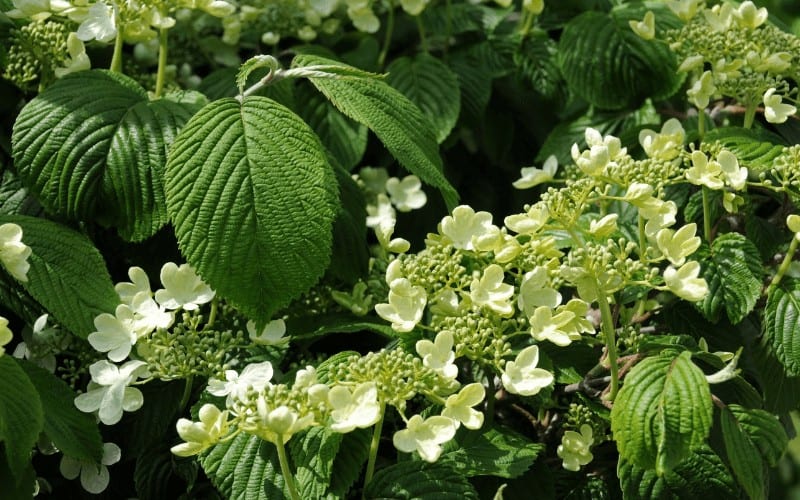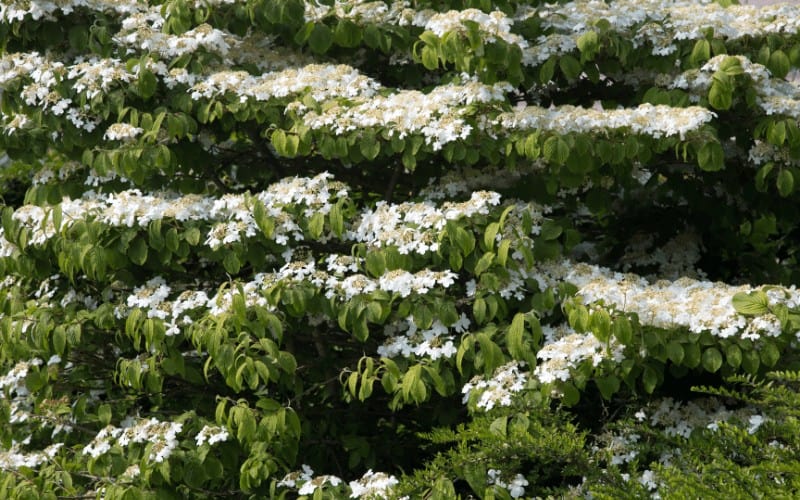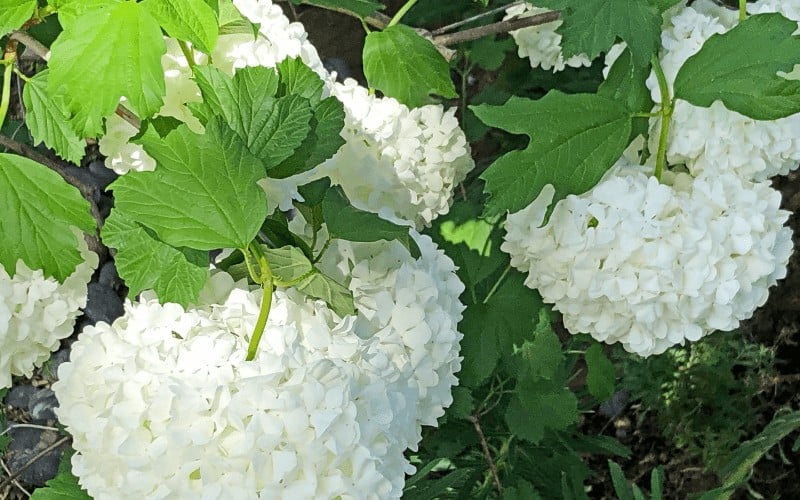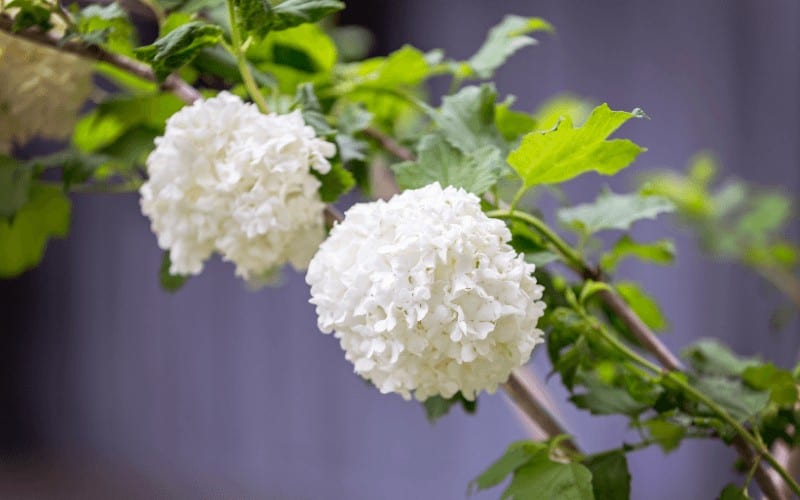If you are considering growing a snowball flower in your garden, you are making a great choice. There are no doubts that these flowers are beautiful, but learning about the different types of snowball bushes will help you decide which you think will be the best fit for your garden.
Snowball bush is a common name used to classify several ornamental plants that produce large clusters of white flowers that resemble heaps of snow.
The major pros that are common with the varieties of this ornamental plant are that they are easy to cultivate and maintain. It also does well with most soil types.
Table of Contents
Are There Different Types of Snowball Bushes?
Before deciding to plant a snowball bush, this is the first thing you should know. Snowball bushes are available in about 4 different types.
The most common type of snowball bush is the European snowball bush, popularly called Roseum. If you are a flower enthusiast, you may be able to reckon if you see one.
In this article, we will introduce you to all the different types you may have seen but could hardly guess rightly that it was a snowball.
There are basically two types of plant species that relate to snowball bushes, depending on the season when they tend to bud their flowers. They are as follows:
Species of Hydrangea, which tend to flower in the summer:
- Hydrangea arborescens
- Hydrangea paniculata
Species of Viburnum, which tend to flower in the spring:
- Viburnum macrocephalum (Chinese snowball bush)
- Viburnum plicatum (Japanese snowball bush)
- Viburnum opulus (European snowball bush)
Types of Snowball Bushes
1. Japanese Snowball Bush

Japanese snowball bush (Viburnum macrocephalum) grows into a large plant considered to be almost the size of a tree. It can grow as tall as 15 feet, producing lacy white gloves of flower clusters hanging heavy on the branches.
You’d think they will require a lot of attention and care to cultivate, but the Japanese snowball bush is quite easy to cultivate.
If you are looking for a plant that will beautify your yard during the spring, the Japanese snowball bush will just be one option to consider because they flower heavily during this season.
The flowers will bud between April and May. Each flower cluster can measure up to 4 inches in diameter.
As summer sets in, the Japanese snowball bush fruits ripen and become mature in late summer. The color change is noticed as it turns from red to black.
We are sure that you will like the beauty that the Japanese snowball bush will give your environment. The attraction of butterflies and other lovely insects makes it even more appealing.
The green leaves gradually turn yellow, red, or purple as springtime elapse. They eventually drop in fall while revealing the stunning branching structure in winter.
Read Also: Types of Plants in The Desert
2. Chinese Snowball Bush

The Chinese Snowball Bush is another species of plant you should be considering growing if you wish to keep your garden and yard alive during spring.
It is considered to be the largest of the viburnum varieties. The flowers can reach up to 6-8 inches across.
One unique character of the Chinese snowball is that they are sterile. This is to say that they do not produce fruits and have no fragrance – perfect for people with plant scent allergies.
They are also as tall as the previous and even more. At full maturity, they reach between 15 to 20 feet in height. Another great thing about it is that they are wide. This is the reason why it has been used mostly as a fence border.
The flowers blossoms during the spring months with large clusters of flower balls. These snow-white flowers start as lime green and slowly turn white as they mature.
Chinese Snowball Bush is easy to cultivate. While it is considered to grow tall, it can also be easily trained and maintained as small trees for as long as you wish.
It is versatile in all kinds of weather. With the proper water, soil, light, and care, it can thrive in any environment.
3. European Snowball Bush

The last snowball bush plant that strives at spring is the European Snowball Bush, also called Cranberrybush. It gives your yard a feel of nature. It is cultivated basically for its flowers and berry fruits.
The fruit may be edible, but only in small quantities. With a very acidic taste, it can be used to make jelly. Consuming the fruit in large quantities may cause vomiting or diarrhea.
This species may try to strive in any condition but has been found to do better on moist, moderately alkaline soils.
A mature European Snowball Bush will reach a height between 13 to 16, with large clusters of white flowers of between 2–4 inches.
This shrub gives your environment that natural appearance. During spring, when the flowers and berries blossom, it attracts birds, butterflies, and beautiful insects.
As the spring season elapses, the white flowers fade to shades of pink, and the green maple-like leaves develop an orange-red or purple tint.
Just like other snowball bush shrubs, it is easy to cultivate, and of course, you can control the height by proper pruning.
Read Also: Types of Plants in The Ocean
4. Fragrant Snowball Bush

You probably may not be familiar with Fragrant Snowball Bush. It is also one awesome snowball bush shrub that should be considered cultivating, especially if you love the fragrance. The mature shrub will reach up to 10 feet high.
It is one of the last of the very fragrant flowers to bloom in spring. During this season, the flowers attract bees and butterflies.
The fragrant snowball grows better in full or partial sun in the Sunset Climate Zones. These zones will be the best places to cultivate one.
The soil should be fertile and moist while having good drainage to prevent the clogging of water. Talking about the soil, anything ranging from slightly acidic to slightly alkaline will just be great.
Whether for beds, borders, cottage gardens, or woodland gardens, Fragrant Snowball Bush is the best fit. It has also be used most often on open walkways.
Are Hydrangeas and Snowball Bushes The Same?
Recall that we earlier stated that there are two types of plant species that relate to snowball bushes.
The name “snowball bush” can refer to a viburnum or a hydrangea. Both of them are similar because they both produce the same type of flowers.
The following are the differences between them.
- Hydrangea shrubs grow 5 – 10 feet tall, while Viburnum grows between 10 – 20 feet. So if you are looking to cultivate a snowball shrub for the height, the Viburnum will be the best to look into.
- Hydrangea will grow well in colder climates, while a Viburnum will not grow in a region colder than the U.S department of agriculture plant hardiness zone 6.
- Hydrangea snowball has smaller flower clusters compared to Viburnum that can get to 12 inches like that of the Chinese Snowball Bush.
- Another difference between these two shrubs is that Hydrangea flowers in summer while Viburnum blossoms in spring.
Recommended Readings:
- When To Prune Hydrangea
- Types Of Medicinal Plants
- Does Spraying Water On Plants Prevent Frost Damage?
- Types of Plants in The Rainforest
- Different Types Of Succulent Plants
Conclusion
All the different types of snowball bushes are similar in the type of flower clusters that it produces. We believe that the knowledge of the differences between these shrubs will help you decide which will be better for your garden.
Having a mixture of both Hydrangeas and Viburnum in your yard will ensure that you have the company of these beautiful white large flowers all through the seasons except for winters.
You should also remember to take note of the climate when deciding.




